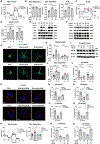ApoE4 Impairs Neuron-Astrocyte Coupling of Fatty Acid Metabolism
- PMID: 33406436
- PMCID: PMC7837265
- DOI: 10.1016/j.celrep.2020.108572
ApoE4 Impairs Neuron-Astrocyte Coupling of Fatty Acid Metabolism
Abstract
Alzheimer's disease (AD) risk gene ApoE4 perturbs brain lipid homeostasis and energy transduction. However, the cell-type-specific mechanism of ApoE4 in modulating brain lipid metabolism is unclear. Here, we describe a detrimental role of ApoE4 in regulating fatty acid (FA) metabolism across neuron and astrocyte in tandem with their distinctive mitochondrial phenotypes. ApoE4 disrupts neuronal function by decreasing FA sequestering in lipid droplets (LDs). FAs in neuronal LDs are exported and internalized by astrocytes, with ApoE4 diminishing the transport efficiency. Further, ApoE4 lowers FA oxidation and leads to lipid accumulation in both astrocyte and the hippocampus. Importantly, diminished capacity of ApoE4 astrocytes in eliminating neuronal lipids and degrading FAs accounts for their compromised metabolic and synaptic support to neurons. Collectively, our findings reveal a mechanism of ApoE4 disruption to brain FA and bioenergetic homeostasis that could underlie the accelerated lipid dysregulation and energy deficits and increased AD risk for ApoE4 carriers.
Keywords: ApoE4; astrocyte; fatty acid metabolism; lipid droplet; lipid transport; metabolic coupling; mitochondria; neuron.
Copyright © 2020 The Author(s). Published by Elsevier Inc. All rights reserved.
Conflict of interest statement
Declaration of Interests The authors declare no competing interests.
Figures







References
-
- Bélanger M, Allaman I, and Magistretti PJ (2011). Brain energy metabolism: focus on astrocyte-neuron metabolic cooperation. Cell Metab. 14, 724–738. - PubMed
Publication types
MeSH terms
Substances
Grants and funding
LinkOut - more resources
Full Text Sources
Other Literature Sources
Medical
Molecular Biology Databases
Research Materials
Miscellaneous

